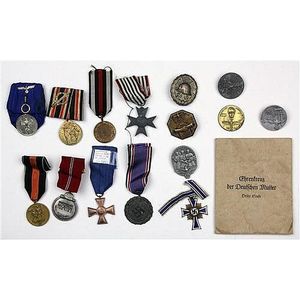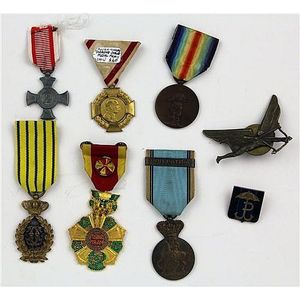WWI Medals and Badges in Gilded Victorian Box
You must be a subscriber, and be logged in to view price and dealer details.
Subscribe Now to view actual auction price for this item
When you subscribe, you have the option of setting the currency in which to display prices to $Au, $US, $NZ or Stg.
- Gilding - Gilding is a method of ornamentation whereby a thin sheet of gold metal is applied to items made of wood, leather, ceramics, glass and silver for decorative purposes.
For furniture including mirrors, the sheet of gold is usually applied over a coating of gesso. Gesso is a mixture of plaster of Paris and gypsum mixed with water and then applied to the carved wooden frames of mirrors and picture frames as a base for applying the gold leaf. After numerous coats of gesso have been applied, allowed to dry and then sanded a coat of "bole", a usually red coloured mixture of clay and glue is brushed on and allowed to dry, after which the gold leaf is applied. Over time parts of the gilding will rub off so the base colour can be seen. In water gilding, this was generally a blue colour, while in oil gilding, the under layer was often yellow. In Victorian times, gilders frequently used red as a pigment beneath the gold leaf.
Metal was often gilded by a process known as fire gilding. Gold mixed with mercury was applied and heated, causing the mercury to evaporate, the long-term effect of which was to kill or disable the craftsman or woman from mercury poisoning. The pursuit of beauty has claimed many victims, not the least of which were the artists who made those pieces so highly sought after today. - Victorian Period - The Victorian period of furniture and decorative arts design covers the reign of Queen Victoria from 1837 to 1901. There was not one dominant style of furniture in the Victorian period. Designers used and modified many historical styles such as Gothic, Tudor, Elizabethan, English Rococo, Neoclassical and others, although use of some styles, such as English Rococo and Gothic tended to dominate the furniture manufacture of the period.
The Victorian period was preceded by the Regency and William IV periods, and followed by the Edwardian period, named for Edward VII (1841 ? 1910) who was King of the United Kingdom and the British Dominions and Emperor of India for the brief period from 1901 until his death in 1910.
This item has been included into following indexes:
- badges - military 181
-
medals, military
- Australian 130
- badges 81
- British 147
- Indian 35
- World War I 186
Visually similar items

German World War I, World War II and Earlier Medals consisting of a World War I wound badge, World War I veterens society mounted medal, World War II 4 years service medal, World War II Luftschultz medal, annexation of the Sudetenland (Czech/German boder)

Vietnam Medal, Japanese Medal with Eastern European War Medals and Badges consisting of a Vietnamese national order 5th class with officers rosette, Japanese victory medal, Romanian 1930's King Carol anniversay medal with bar for officers, Romanian army of

World War I medal group 1914-18 war medal 99496 GNR. A.T.TURNBULL. R.A. 1914-18 Victory medal 99496 GNR. A. T. TURNBULL. R. A. 1914-18 war medal LIEUT. A. TURNBULL 1914-18 Victory medal LIEUT. A. TURNBULL together with two medal miniature group, ribbons an

World War I group x 3 medals (1914-15 star) to Anzac 1st day Lander. Gallipoli Landing 25 March 1915 among last off, evac. 13 November 2015. Served no's 1 & 3 casualty clearing station. Major R.A. Lowry AMC, AIF. to France 13 November 1917 with 9th field a
